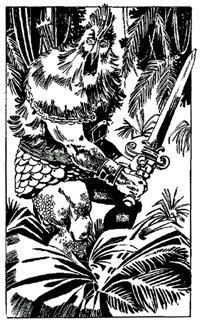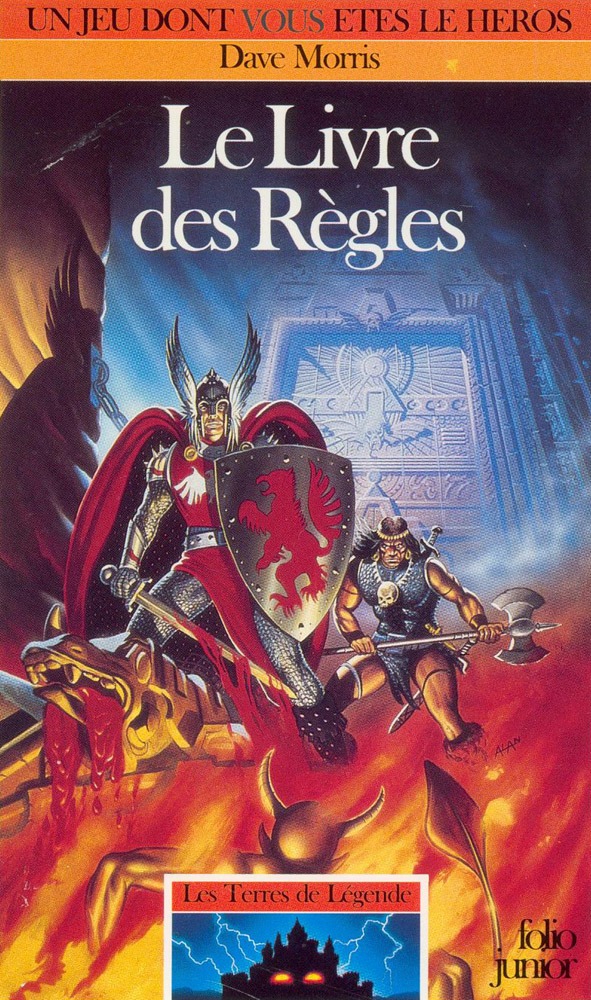Chapter Seven
This is the bestiary, and it's this chapter in which, for me, Dragon Warriors stops being just another fantasy RPG (sorry, Fantasy Rôle-Playing game) rehashing Tolkien and D&D and goes on to do it's own thing. It's not a clean break, there's still a lot of Tolkien around, starting with the very first entry, that of Adventurers.
Adventurers can be either Human, Elves or Dwarves. The book hasn't mentioned non-human characters before this section, but if you look up the sections for Elves or Dwarves in the bestiary it does mention you can play as one of those. You don't get bonuses or penalties to your characteristics if you do, rather you need to have rolled certain results when creating a character. If your Strength is less than 12, and your Psychic Talent or Looks are more than 11, you aren't a Dwarf. While not listed in the Adventurer section, you can play as a Halfling, but can only be a Knight, have -1 Attack, and can't progress beyond 3rd Rank, so it's not really a viable option. No restriction on characteristics there for some reason.
So, you've got adventuring parties made of Humans, Elves, Dwarves and maybe Halflings. Elves are super special, though stated not to have souls. Fairly standard.
You've also got classic monsters like Dragons (well, it's half of the series name), Basilisks, Gorgons, Manticores. There's the usual Giant Rats, Giant Scorpions, Giant Spiders. Various familiar types of undead. You've got dangerous animals like Crocodiles, Bears and Sabre-Tooth Tigers.
There's Apemen (described as a offshoot of humanity's evolution) and Snow Apes (which are Apemen but good at hiding in snow, and that gives them their own section of 3 sentences, rather than 3 sentences in the Apemen section). There's Orcs that serve any evil master they can find. There's also the Volucreth, another race of sentient humanoids that has their own society and live in some jungle somewhere.

Volucreth
Again, all very standard. Not that that's a bad thing, nothing wrong with LotR or D&D trappings. Two examples of that, well, LotR and D&D. But apparently Morris wanted to go his own way and deliberately move away from that. The best example of that seems to be the Goblin.
Dragon Warriors Goblins don't have towns or nations or industry or serve dark lords. They are "malicious sprites" that cause trouble for people walking around in the wild, especially at night. They have "sorcerous pranks", no rules or stats but examples given, of a bat flying into a rider's face and knocking them off their horse, or a horse going lame. If you catch one, you can frighten it into making any sort of deal, and it will have to abide to the letter of the agreement, but won't abide by the spirit if it can twist your words.
They aren't a race or a culture, they are the things from fairy-tales (the old, dark sort) and folktales. I immediately thought "fae" while re-reading that, and apparently Morris uses the word "fay" nowdays, so I was close (especially on a QWERTY keyboard).
There's also the Pazuzu, described as being a monster from warm southern lands, some of which have snuck north on "ships returning from the Crusade". I personally like the Death's Head, a disembodied head with wings and a forehead horn (which fade away in sunlight) which will fly around, kill someone, eat their head, attach itself to their neck and use their zombie body until it decomposes.
A minus, though, almost no monsters have scores for characteristics like Strength or Reflexes. Which, as everyone acts in descending order of Reflexes, is a bit of an omission.
Chapter Eight
This deals with traveling and encounters. IMHO, the random encounter tables are a bit rubbish. There's a example of running adventures, and that mentions rolling a vampire in broad daylight and having to re-roll. Also, you'd have to re-roll trolls in daylight, pythons or sabre-tooth tigers in cold climates and Rank inappropriate stuff. The same tables tend to include Wolves and Dragons.
OTOH, there's also mention of disputation, which is where a Knight sets up a camp next to a bridge or crossroads or something and challenges other Knights to (generally non-lethal) combat to make a name for themselves. Which is a lot more interesting and says more about the setting.
Chapter Nine
Here we have general advice on running campaigns, NPCs, keeping track of important things and the like. It states that the setting they use is "an indistinct land and place, with perhaps a strong flavour of late Dark Ages and early Medieval Europe", but that you can choose others. Which would be a shame, because IMHO, the setting is the big selling point of the series. And, not surprisingly, the rules of the series lean towards the setting used by the creators of the setting.
It also mentions that you roll 3d6 for each group of monsters you run into to determine their Reflexes score. This doesn't seem a great place to put that, between "remember to check for surprise" and "intelligent monsters should act intelligently". Also, all monsters (barring a few rare exceptions) have the same 3d6? I'm guessing though, they don't get bonuses or penalties for exceptional Reflexes the same way PCs do. Are we supposed to re-roll for Elves who are stated to have a minimum Reflexes score, or is that just for Elf PCs?
Followed by an introductory adventure, intended to ease new players and GMs into things. Which, far enough, there's some groups of easy monsters to fight, some puzzles and puzzle monsters, a trap and a magical effect or two, an end boss. So you'll get used to rolling to hit, evading, resisting magic and a bit on how the party should work together.
The backstory isn't bad. A priest (of the "carries a cross" kind) in the town you are staying in is obsessed with the treasure supposed to be in not-King Arthur's tomb. If pushed for more exposition, he tells a story about how he went looking for it with a bunch of adventurers beforehand, who turned out to be unsavory types. One of them killed an elf, so the other elves killed the rest of them when they reached the tomb, but spared the priest because he was holding a cross and was "not one of them". So he ran away wearing a cloak given to him by the elf-lord to keep him safe, but unraveled it as he went to leave a trail of thread behind. Only it's one of those magic elves threads that can only be seen under the full moon, and as it happens it'll be the full moon soon.
After defeating the spectre of not-Mordred at the end of the adventure, they find the treasure: a silver crown, a handful of grain, a ploughshare, a wooden cross and and old book. If the priest is still alive, he will realise that they are the treasures of not-King Arthur's land: the King, the Land, the People, the Faith and the Law.
Ok, fair enough, but the things making up the adventure itself are a bit underwhelming. You've got things seemingly plunked in to challenge players without making any sense in context. There's a Gorgon (which is from another mythology to begin with) that presumably has spent the last 500 years sitting around in a corridor doing nothing. To get past her, you'll want to use the helmet with the mirrored visor that just happens to have been in a previous corridor for no reason, guarded by a Giant Spider that doesn't have any easy access in or out of the tomb. What does it eat? You've got 2 magic fountains, and one of them is full of acid, but if you drink using a silver goblet you found earlier it protects you from the effects of passing through a magic gateway. There's no clues to having to use the goblet for this.
Chapter Ten
The last chapter has a little more advice about fantasy role-playing. Not "fantasy rôle-playing" in this chapter for some reason. This is fairly basic stuff, about deciding on your characters attitudes towards things, and coming up with a backstory. It mentions that Dragon Warriors doesn't have tables for this, it's something PCs and the GM should come up with, something Morris seemed to have changed his mind on later in the series. It also mentions the worth of developing the local setting and talks a bit about strategy and tactics and hiring NPCs. Nowdays, this seems rather redundant, of course, but it also seems a bit redundant as the book already has included some of this before.
To sum up the book, the rules seem to be solid, if simple, there are some issues there but nothing game-breaking. It definitely could have used some editing, the organisation of the content isn't great, and there'd be problems if you were trying to look up certain rules which aren't in obvious places. However, most of those aren't important. I'd be nice if the information about securing lodging and how Sorcerors usually aren't allowed in monasteries would have been in the Chapter about travelling, but it's hardly essential.
On the definite plus side (or at least the definite not minus side), the book at no time tries to be "edgy" or otherwise makes you grab for the brain bleach. No child abuse, rape, racism, use of real atrocities in offensive ways or unnatural acts with animals. Ok, damning with faint praise there, but that's hardly a given in RPGs. Good, wholesome, malicious sprite hitting fun.
As mentioned, the selling point of the series is the setting and world-building, and that hasn't really gotten going yet, but will develop over the next few books. And almost entirely forget you could choose an Elf or Dwarf character.



